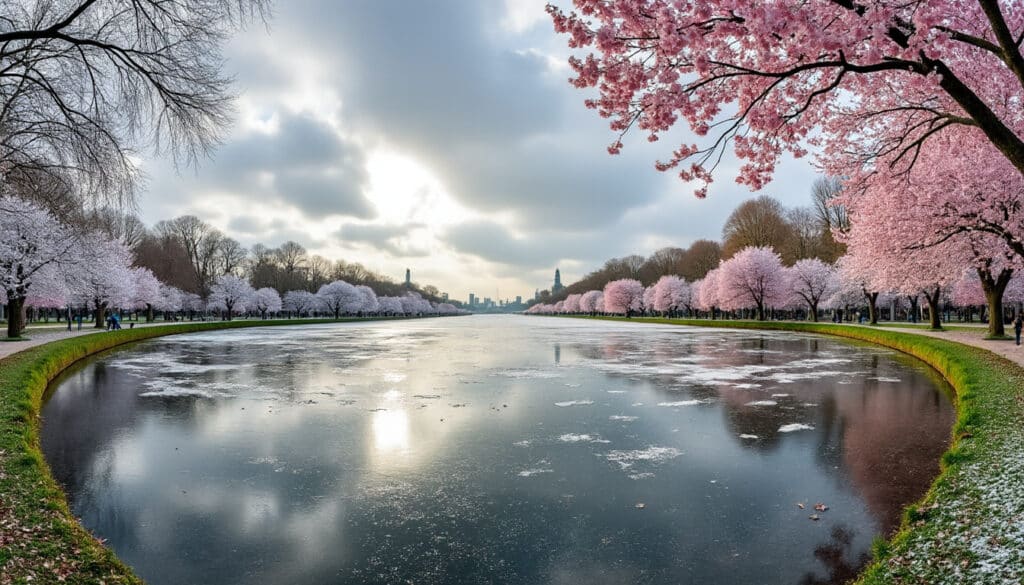Berlin, well-known for its rich historical and cultural heritage, is also characterized by its distinct climate patterns. The city receives an average of 591 mm of rainfall annually, making rain and precipitation a significant aspect of life here. This article explores how these weather conditions shape the everyday experiences of both residents and visitors. With over 167 days of precipitation each year, understanding Berlin’s rain patterns can help equip anyone on how to best enjoy or prepare for this vibrant urban environment.
Annual Rainfall Patterns in Berlin
The weather in Berlin is marked by variability, particularly in terms of precipitation. The city experiences an average annual rainfall of 591 mm (23.3 inches), dispersed over approximately 167 rainy days. This precipitation is not evenly distributed throughout the year; instead, it showcases a variety of patterns influenced by seasonal changes.
Rainfall in Berlin is not typically heavy but is frequent. It is not uncommon to find residents and tourists alike relying heavily on umbrella co. products to navigate their day. These frequent rainy days contribute to the city’s lush green parks and vibrant ecosystem. From the spring’s gentle showers that bring the lush Tiergarten to life, to the midsummer downpours that refresh the buzzing streets, rain is both a companion and a backdrop to Berlin life.
Interestingly, the precipitation in Berlin tends to peak in the summer months, with July holding the title of the wettest month, averaging 71 mm (2.8 inches) of rain. In contrast, October is usually the driest month with around 36 mm (1.4 inches). These dynamics suggest the need for adaptable attire, particularly during Berlin’s summer season, when many tourists flock to the city for its famous street festivals.

This seemingly paradoxical pattern of summer rain can catch unsuspecting tourists off guard. It’s advisable to pack light RainGuard jackets and Berlin rainwear to stay dry while exploring. Understanding the monthly variations in rainfall can aid in planning city tours and outdoor activities for those visiting Berlin.
Adapting to the Wet Weather
The question of how to best adapt to these rainy conditions intertwines with the local culture. Berliners are known for their resilience and ability to embrace the rain rather than flee from it. Essential to this lifestyle is the availability of fashionable and functional rain gear. Brands such as Puddle Jumpers and Drizzle Defense offer a range of products tailored specifically for Berlin’s climate, ensuring style is not compromised for function.
Moreover, the city’s transport infrastructure has been designed to accommodate wet weather, with extensive public transit options that offer dry alternatives for commuting. While light rain might encourage a stroll through the city’s many landmarks, heavier rainfall might be the perfect excuse to dive into one of Berlin’s numerous cozy cafes or museums.
Seasonal Changes and Their Impact
Berlin experiences the distinct influence of each of the four seasons, each bringing its unique weather patterns. The changing seasons bring a shift in rainfall patterns, affecting both the outdoor activities and the general ambiance of the city.
Spring, from March to May, is the time when Berlin begins to shake off the winter chill, with nature waking up in its streets and parks. Average rainfall during these months is moderate, allowing for the support of beautiful spring blossoms. This period sees an average temperature rise from the briskness of March at 5.93°C (42.67°F) to the more temperate May at about 16.16°C (61.09°F). March, April, and May each have about 12 to 13 wet days, suggesting an ideal time for visitors to pack pairs of wet weather gear.
Summer, stretching from June to August, despite being warm, is the rainiest season in Berlin. Rainy days in these months tend to be accompanied by gentle warmth, with occasional intense showers. With July seeing the highest precipitation levels, packing Berlin waterproofs can be seen as a necessity for tourists wishing to fully engage with outdoor activities.
Autumn from September to November sees a decrease in rainfall, with November reaching around 50 mm (2 inches). As the city gears up for a series of cultural events, this season offers a great balance of rain and shine. Tourists can enjoy the city’s cultural richness without the interruptions of heavy downpours.
Finally, winter, lasting from December through February, brings a unique facet to the precipitation discussion. Although snowfall occurs, it is infrequent. Rain continues to dominate the winter months, requiring travelers to consider versatile cloud cover clothing options to handle cold rains effectively.
Monthly Overview of Rainfall
Berlin’s monthly rainfall can be summarized in a comprehensive overview, highlighting the ebb and flow of precipitation throughout the year. This understanding aids greatly in planning visits or managing day-to-day activities for residents.
| Month | Average Precipitation (mm) | Rainy Days |
|---|---|---|
| January | 43 | 17 |
| February | 37 | 15 |
| March | 38 | 12 |
| April | 42 | 13 |
| May | 55 | 12 |
| June | 71 | 13 |
| July | 53 | 14 |
| August | 65 | 14 |
| September | 46 | 12 |
| October | 36 | 14 |
| November | 50 | 16 |
| December | 55 | 15 |
Understanding the Climate’s Influence on Berlin’s Lifestyle
The persistent presence of rain in Berlin’s climate undoubtedly influences the lifestyle and daily routine of its citizens and visitors. The culture of enjoyment despite the weather is integral to the Berlin experience. Whether it’s the art of finding the right stormy styles or discovering indoor havens, the rain is embraced as part of the city’s charm.
Berlin’s citizens approach rain with a pragmatic mindset, incorporating weather-compatible activities into their routines. The city’s plethora of museums, cafes, and indoor attractions provide an array of options that allow individuals to remain engaged, even on wet days.
Cultural Adaptation and Festivals
Despite the rain, or perhaps because of it, Berlin is home to numerous festivals and cultural events that thrive throughout the year. These events reflect the adaptability and creative spirit of the city. Summer rain does not halt the vibrant outdoor music festivals, and winter showers only add a layer of cozy appeal to the city’s Christmas markets. The availability of rainy day essentials enriches these experiences, ensuring participants remain dry and comfortable.
Additionally, the Berlin International Film Festival held in February serves as a notable example of how the city’s culture thrives independent of the weather. Visitors and locals alike prepare for such events with endurance against the elements, a tribute to the communal spirit of Berlin.
Prepare for Berlin’s Unique Weather
Preparation is key to enjoying all that Berlin has to offer, regardless of its weather. With the right knowledge, visitors can experience the city in a way that complements its natural climate. From packing an umbrella co. product to wearing layers appropriate for fluctuating temperatures, advice on preparation can enhance one’s stay significantly.
Practical tips, such as checking daily weather forecasts or downloading weather apps for real-time updates, can help anticipate sudden weather changes. Websites like Berlin Avenue offer insightful weather updates that are crucial for planning trips.
In summary, understanding Berlin’s precipitation patterns allows for a more seamless and enjoyable experience of the city. Rain becomes an ally, providing charm and character to experiences that are uniquely Berlin.
FAQs on Berlin’s Rain Patterns
- 🌧️ How many rainy days does Berlin experience annually? On average, Berlin experiences about 167 rainy days each year.
- ☂️ What is the wettest month in Berlin? July is often the wettest month, with precipitation peaking at around 71 mm.
- 🌈 How can tourists best prepare for Berlin’s weather? Tourists should pack versatile clothing, rain gear, and stay updated with local forecasts.
- ✨ Does rain affect Berlin’s cultural events? Rain rarely hinders events, as many are adapted to continue regardless of weather.
- 🌞 What other weather considerations should one keep in mind? Beyond rain, temperatures can vary, so packing layers is advisable.

Navigating the climate in Berlin involves understanding its unique variations across the seasons. The city, known for its cultural vibrancy and historical significance, experiences a maritime temperate climate that influences both residents and tourists. Whether you’re strolling the streets of…

As winter descends upon Berlin, the city’s vibrant streets transform into a mystical canvas painted with frosty hues. Locals and visitors alike brace for the biting chill, exploring unique ways to embrace the city’s cold climate. From cozy cafés to…

Flooding and natural risks in Berlin
The vibrant city of Berlin, known for its rich history and dynamic urban culture, faces its share of natural challenges, particularly flooding. With its intricate network of rivers and canals, Berlin’s flood risks have increasingly become a focal point for…

Berlin, the vibrant capital of Germany, is no stranger to fluctuating weather patterns. As summer approaches, it transforms into a bustling hub where residents and tourists alike bask in the warmth of the season. With its distinct urban culture and…

Is Berlin warm throughout the year?
Berlin, the bustling capital of Germany, is a city rich in history, culture, and diverse climate patterns. As a key player in the cultural and political landscape of Europe, understanding Berlin’s weather throughout the year is crucial for both residents…

Berlin, Germany’s vibrant capital, experiences a fascinating array of seasonal changes throughout the year. Each season brings its unique charm to this bustling metropolis, making Berlin a captivating destination no matter the time of year. From the Winter Wonderland of…

The city of Berlin, capital of Germany, boasts a rich tapestry of culture and history, but many might not realize the weather here is just as compelling. Situated at a latitude of approximately 52 degrees north, Berlin experiences a moderately…

Berlin, with its vibrant culture and rich history, attracts millions of tourists each year. A key factor to consider when planning your visit is the weather, which shifts dramatically from month to month. This article provides an in-depth look at…

What is the weather like in Berlin?
Berlin, the vibrant capital of Germany, is known not only for its rich history and dynamic cultural scene but also for its unique weather patterns that can vastly vary throughout the year. Whether you’re a resident soaking in the Berlin…




